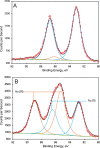Oxygen Generation via Water Splitting by a Novel Biogenic Metal Ion-Binding Compound
- PMID: 33962982
- PMCID: PMC8231713
- DOI: 10.1128/AEM.00286-21
Oxygen Generation via Water Splitting by a Novel Biogenic Metal Ion-Binding Compound
Abstract
Methanobactins (MBs) are small (<1,300-Da) posttranslationally modified copper-binding peptides and represent the extracellular component of a copper acquisition system in some methanotrophs. Interestingly, MBs can bind a range of metal ions, with some being reduced after binding, e.g., Cu2+ reduced to Cu+. Other metal ions, however, are bound but not reduced, e.g., K+. The source of electrons for selective metal ion reduction has been speculated to be water but never empirically shown. Here, using H218O, we show that when MBs from Methylocystis sp. strain SB2 (MB-SB2) and Methylosinus trichosporium OB3b (MB-OB3) were incubated in the presence of either Au3+, Cu2, or Ag+, 18,18O2 and free protons were released. No 18,18O2 production was observed in the presence of either MB-SB2 or MB-OB3b alone, gold alone, copper alone, or silver alone or when K+ or Mo2+ was incubated with MB-SB2. In contrast to MB-OB3b, MB-SB2 binds Fe3+ with an N2S2 coordination and will also reduce Fe3+ to Fe2+. Iron reduction was also found to be coupled to the oxidation of 2H2O and the generation of O2. MB-SB2 will also couple Hg2+, Ni2+, and Co2+ reduction to the oxidation of 2H2O and the generation of O2, but MB-OB3b will not, ostensibly as MB-OB3b binds but does not reduce these metal ions. To determine if the O2 generated during metal ion reduction by MB could be coupled to methane oxidation, 13CH4 oxidation by Methylosinus trichosporium OB3b was monitored under anoxic conditions. The results demonstrate that O2 generation from metal ion reduction by MB-OB3b can support methane oxidation. IMPORTANCE The discovery that MB will couple the oxidation of H2O to metal ion reduction and the release of O2 suggests that methanotrophs expressing MB may be able to maintain their activity under hypoxic/anoxic conditions through the "self-generation" of dioxygen required for the initial oxidation of methane to methanol. Such an ability may be an important factor in enabling methanotrophs to not only colonize the oxic-anoxic interface where methane concentrations are highest but also tolerate significant temporal fluctuations of this interface. Given that genomic surveys often show evidence of aerobic methanotrophs within anoxic zones, the ability to express MB (and thereby generate dioxygen) may be an important parameter in facilitating their ability to remove methane, a potent greenhouse gas, before it enters the atmosphere.
Keywords: aerobic methane oxidation; chalkophore; gold nanoparticle; methanobactin; methanotroph; water oxidation.
Figures








References
-
- Choi DW, Kunz RC, Boyd ES, Semrau JD, Antholine WE, Han JI, Zahn JA, Boyd JM, de la Mora AM, DiSpirito AA. 2003. The membrane-associated methane monooxygenase (pMMO) and pMMO-NADH:quinone oxidoreductase complex from Methylococcus capsulatus Bath. J Bacteriol 185:5755–5764. 10.1128/JB.185.19.5755-5764.2003. - DOI - PMC - PubMed
-
- Fox BG, Hendrich MP, Surerus KK, Andersson KK, Froland WA, Lipscomb JD, Münck E. 1993. Mössbauer, EPR, and ENDOR studies of the hydroxylase and reductase components of methane monooxygenase from Methylosinus trichosporium Ob3b. J Am Chem Soc 115:3688–3701. 10.1021/ja00062a039. - DOI
Publication types
MeSH terms
Substances
LinkOut - more resources
Full Text Sources
Other Literature Sources
Miscellaneous

